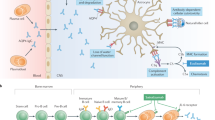Abstract
In the late 19th century, Wilhelm Uhthoff reported on a series of patients with acute optic neuritis who manifested similar recurrent, stereotyped visual symptoms that were of paroxysmal onset, short in duration, and reversible. These 'Uhthoff's phenomena', which are a feature of multiple sclerosis (MS) and other demyelinating diseases, can be triggered by factors including the perimenstrual period, exercise, infection, fever, exposure to high ambient temperatures, and psychological stress. Here, we characterize the clinical, pathophysiological and neurotherapeutic challenges associated with Uhthoff's phenomena, and discuss the differentiation of these events from other paroxysmal, acute or subacute changes in functional capabilities and neurological symptoms in MS. For instance, whereas MS exacerbations are contingent on immune dysregulation, Uhthoff's phenomena are predicated on ion channel modifications, in conjunction with thermoregulatory derangements that transiently alter the conduction properties of demyelinated axons. An understanding of these pathophysiological underpinnings of Uhthoff's phenomena is germane to their recognition and timely treatment.
This is a preview of subscription content, access via your institution
Access options
Subscribe to this journal
Receive 12 print issues and online access
$209.00 per year
only $17.42 per issue
Buy this article
- Purchase on Springer Link
- Instant access to full article PDF
Prices may be subject to local taxes which are calculated during checkout




Similar content being viewed by others
References
Smith, K. J. & McDonald, W. I. The pathophysiology of multiple sclerosis: the mechanisms underlying the production of symptoms and the natural history of the disease. Philos. Trans. R. Soc. Lond. B Biol. Sci. 354, 1649–1673 (1999).
Uhthoff, W. Untersuchungen über die bei der multiplen Herdsklerose vorkommenden Augenstörungen [German]. Arch. Psychiatr. Nervenkr. 21, 303–420 (1890).
Rushton, W. A. Initiation of the propagated disturbance. Proc. R. Soc. Lond. B Biol. Sci. 124, 210–243 (1937).
Davis, S. et al. Modeling Uhthoff's phenomenon in MS patients with internuclear ophthalmoparesis. Neurology 70, 1098–1106 (2008).
Frohman, T. C., Davis, S. L. & Frohman, E. M. Modeling the mechanisms of Uhthoff's phenomenon in MS patients with internuclear ophthalmoparesis. Ann. NY Acad. Sci. 1233, 313–319 (2011).
Polman, C. H. et al. Diagnostic criteria for multiple sclerosis: 2010 revisions to the McDonald criteria. Ann. Neurol. 69, 292–302 (2011).
Fromont, A. et al. Long-lasting and isolated Uhthoff's phenomenon after effort preceding multiple sclerosis [French]. Rev. Neurol. (Paris) 166, 61–65 (2009).
Smith, K. J. Conduction properties of central demyelinated and remyelinated axons, and their relation to symptom production in demyelinating disorders. Eye (Lond.) 8, 224–237 (1994).
McDonald, W. I. & Sears, T. A. Effect of demyelination on conduction in the central nervous system. Nature 221, 182–183 (1969).
Frohman, E. M. et al. The utility of MRI in suspected MS: report of the Therapeutics and Technology Assessment Committee of the American Academy of Neurology. Neurology 61, 602–611 (2003).
Frohman, E. M., Racke, M. K. & Raine, C. S. Multiple sclerosis—the plaque and its pathogenesis. N. Engl. J. Med. 354, 942–955 (2006).
Mills, D. et al. Break in binocular fusion during head turning in MS patients with INO. Neurology 71, 458–460 (2008).
Wingerchuk, D. & Rodriguez, M. Premenstrual multiple sclerosis pseudoexacerbations: role of body temperature and prevention with aspirin. Arch. Neurol. 63, 1005–1008 (2006).
Selhorst, J. B. & Saul, R. F. Uhthoff and his symptom. J. Neuroophthalmol. 15, 63–69 (1995).
Zee, D. S. Internuclear ophthalmoplegia: pathophysiology and diagnosis. Baillieres Clin. Neurol. 1, 455–470 (1992).
Frohman, T. C. et al. Pearls & Oy-sters: the medial longitudinal fasciculus (MLF) in ocular motor physiology. Neurology 70, e57–e67 (2008).
Ventre, J., Vighetto, A., Bailly, G. & Prablanc, C. Saccade metrics in multiple sclerosis: versional velocity dysconjugacy as the best clue? J. Neurol. Sci. 102, 144–149 (1991).
Frohman, E. M. et al. Quantitative oculographic characterisation of internuclear ophthalmoparesis in multiple sclerosis: the versional dysconjugacy index Z score. J. Neurol. Neurosurg. Psychiatry 73, 51–55 (2002).
Frohman, E. M. et al. MRI characteristics of the MLF in MS patients with chronic internuclear ophthalmoparesis. Neurology 57, 762–768 (2001).
Frohman, T. C. et al. Accuracy of clinical detection of INO in MS: corroboration with quantitative infrared oculography. Neurology 61, 848–850 (2003).
Frohman, E. M., O'Suilleabhain, P., Dewey, R. B. Jr, Frohman, T. C. & Kramer, P. D. A new measure of dysconjugacy in INO: the first-pass amplitude. J. Neurol. Sci. 210, 65–71 (2003).
Frohman, E. M. et al. Corticosteroids for multiple sclerosis: I. Application for treating exacerbations. Neurotherapeutics 4, 618–626 (2007).
Boster, A. et al. Intense immunosuppression in patients with rapidly worsening multiple sclerosis: treatment guidelines for the clinician. Lancet Neurol. 7, 173–183 (2008).
Malhotra, A. S. & Goren, H. The hot bath test in the diagnosis of multiple sclerosis. JAMA 246, 1113–1114 (1981).
Polman, C. H., Bertelsmann, F. W., van Loenen, A. C. & Koetsier, J. C. 4-aminopyridine in the treatment of patients with multiple sclerosis. Long-term efficacy and safety. Arch. Neurol. 51, 292–296 (1994).
Goodman, A. D. et al. Sustained-release oral fampridine in multiple sclerosis: a randomised, double-blind, controlled trial. Lancet 373, 732–738 (2009).
Acknowledgements
The authors thank Kimberly Hoggatt for her preparation of the artwork contained within Figures 1 and 4. The authors have received research funding from the National Multiple Sclerosis Society (grants RG 3780A3/3 and PP1485 to E. M. Frohman; RG 4091A3/1 to Robert Fox at Cleveland Clinic and subcontracted to E. M. Frohman; RG 4212-A-4 to Laura J. Balcer at New York University and subcontracted to E. M. Frohman; RG 4043A1/1 to S. L. Davis) and the National Eye Institute (grants R01 EY 014993 and R01 EY 019473 to Laura J. Balcer subcontracted to E. M. Frohman). E. M. Frohman has also received funding from Dale Energy Corporation, the Braxton Debbie Angela Dillon and Skip (DADS) Donor Advisor Fund, and the Cain Denius MS Research Fund. Written consent for publication of the case report was obtained from the family of the patient.
Author information
Authors and Affiliations
Contributions
All authors researched the data for the article, made substantial contributions to discussions of the content, wrote the text, and reviewed and/or edited the manuscript before submission.
Corresponding author
Ethics declarations
Competing interests
The authors declare no competing financial interests.
Rights and permissions
About this article
Cite this article
Frohman, T., Davis, S., Beh, S. et al. Uhthoff's phenomena in MS—clinical features and pathophysiology. Nat Rev Neurol 9, 535–540 (2013). https://doi.org/10.1038/nrneurol.2013.98
Published:
Issue Date:
DOI: https://doi.org/10.1038/nrneurol.2013.98
This article is cited by
-
Somatosensory evoked potentials and magnetic resonance imaging of the central nervous system in early multiple sclerosis
Journal of Neurology (2023)
-
Hearing abnormalities in multiple sclerosis: clinical semiology and pathophysiologic mechanisms
Journal of Neurology (2022)
-
Peripheral nervous system in multiple sclerosis—understanding the involvement via autonomic nervous system
Neurological Sciences (2021)
-
The investigation of acute optic neuritis: a review and proposed protocol
Nature Reviews Neurology (2014)



